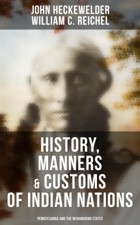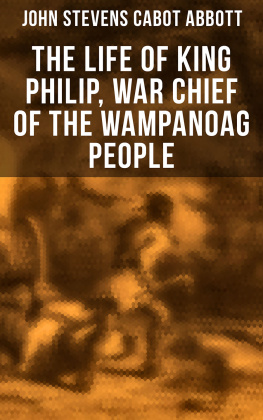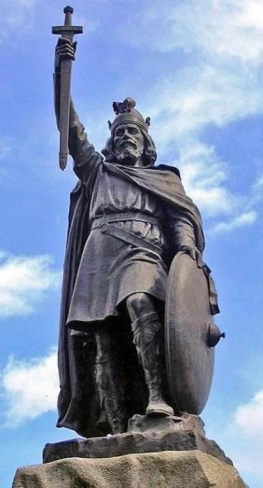Reading suggestions
 | Franz Boas:
The Central Eskimo (Illustrated) |
 | Alexander Scott Withers:
The Chronicles of Border Warfare (Complete Edition) |
 | John Heckewelder, William C. Reichel:
History, Manners & Customs of Indian Nations (Pennsylvania and the Neighboring States) |
Chapter I.
Landing of the Pilgrims
1620-1621
Arrival of the Mayflower.
O n the 11th of November, 1620, the storm-battered Mayflower, with its band of one hundred and one Pilgrims, first caught sight of the barren sand-hills of Cape Cod. The shore presented a cheerless scene even for those weary of a more than four months voyage upon a cold and tempestuous sea. But, dismal as the prospect was, after struggling for a short time to make their way farther south, embarrassed by a leaky ship and by perilous shoals appearing every where around them, they were glad to make a harbor at the extremity of the unsheltered and verdureless cape. Before landing, they chose Mr. John Carver, "a pious and well-approved gentleman," as the governor of their little republic for the first year. While the carpenter was fitting up the boat to explore the interior bend of the land which forms Cape Cod Bay, in search of a more attractive place of settlement, sixteen of their number set out on foot on a short tour of discovery. They were all well armed, to guard against any attack from the natives.
Explorations.
Captain Weymouth.
Indian captives.
Cautiously the adventurers followed along the western shore of the Cape toward the south, when suddenly they came in sight of five Indians. The natives fled with the utmost precipitation. They had heard of the white men, and had abundant cause to fear them. But a few years before, in 1605, Captain Weymouth, on an exploring tour along the coast of Maine, very treacherously kidnapped five of the natives, and took them with him back to England. This act, which greatly exasperated the natives, and which led to subsequent scenes of hostility and blood, it may be well here to record. It explains the reception which the Pilgrims first encountered.
Enticing the natives.
The seizure.
Trophies.
Necessity for caution.
Captain Weymouth had been trafficking with the natives for some time in perfect friendship. One day six Indians came to the ship in two canoes, three in each. Three were enticed on board the ship, and were shut up in the cabin. The other three, a little suspicious of danger, refused to leave their canoe, but, receiving a can of pease and bread, paddled to the shore, where they built a fire, and sat down to their entertainment. A boat strongly manned was then sent to the shore from the ship with enticing presents, and a platter of food of which the Indians were particularly fond. One of the natives, more cautious than the rest, upon the approach of the boat, retired to the woods; the other two met the party cordially. They all walked up to the fire and sat down, in apparent friendship, to eat their food together. There were six Englishmen and two naked, helpless natives. At a given signal, while their unsuspecting victims were gazing at some curiosities in a box, the English sprang upon them, three to each man. The natives, young, vigorous, and lithe as eels, struggled with Herculean energy. The kidnappers, finding it difficult to hold them by their naked limbs, seized them by the long hair of their heads, and thus the terrified creatures were dragged into the boats and conveyed to the ship. Soon after this Captain Weymouth weighed anchor, and the five captives were taken to England. He also took, as trophies of his victory, the two canoes, and the bows and arrows of these Indians. Sundry outrages of a similar character had been perpetrated by European adventurers all along the New England coast. The Pilgrims were well aware of these facts, and consequently they were not surprised at the flight of the Indians, and felt, themselves, the necessity of guarding against a hostile attack.
Discovery of a wigwam.
The English pursued the fugitives vigorously for many miles, but were unable to overtake them. At last night came on. They built a camp, kindled a fire, established a watch, and slept soundly until the next morning. They then continued their course, following along in the track of the Indians. After some time they came to the remains of an Indian wigwam, surrounded by an old corn-field. Finding concealed here several baskets filled with ears of corn, they took the grain, so needful for them, intending, should they ever meet the Indians, to pay them amply for it. With this as the only fruit of their expedition, they returned to the ship.
New enterprises.
Soon after their return preparations were completed for a more important enterprise. The shallop was launched, and well provided with arms and provisions, and thirty of the ship's company embarked for an extensive survey of the coast. They slowly crept along the barren shore, stopping at various points, but they could meet with no natives, and could find no harbor for their ship, and no inviting place for a settlement. Drifting sands and gloomy evergreens, through which the autumnal winds ominously sighed, alone met the eye. They discovered a few deserted dwellings of the Indians, but could catch no sight of the terrified natives. After several days of painful search, they returned disheartened to the ship.
The return of the explorers.
It was now the 6th of December, and the cold winds of approaching winter began to sweep over the water, which seemed almost to surround them. Imagination can hardly conceive a more bleak and dreary spot than the extremity of Cape Cod. It was manifest to all that it was no place for the establishment of a colony, and that, late as it was in the year, they must, at all hazards, continue their search for a more inviting location. Previous explorers had entered Cape Cod Bay, and had given a general idea of the sweep of the coast.
New expedition.
Sight of some Indians.
Cheerless encampment.
A new expedition was now energetically organized, to proceed with all speed in a boat along the coast in search of a harbor. The wind, in freezing blasts, swept across the bay as they spread their sail. Their frail boat was small and entirely open, and the spray, which ever dashed over these hardy pioneers, glazed their coats with ice. They soon lost sight of the ship, and, skirting the coast, were driven rapidly along by the fair but piercing wind. The sun went down, and dark night was approaching. They had been looking in vain for some sheltered cove into which to run to pass the night, when, in the deepening twilight, they discerned twelve Indians standing upon the shore. They immediately turned their boat toward the land, and the Indians as immediately fled. The sandy beach upon which their boat grounded was entirely exposed to the billows of the ocean. With difficulty they drew their boat high upon the sand, that it might not be broken by the waves, and prepared to make themselves as comfortable as possible. It was, indeed, a cheerless encampment for a cold, windy December night. Fortunately there was wood in abundance with which to build a fire, and they also piled up for themselves a slight protection against the wind and against a midnight attack. Then, having commended themselves to God in prayer, they established a watch, and sought such repose as fatigue and their cold, hard couch could furnish.













